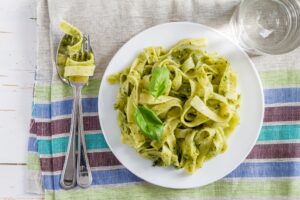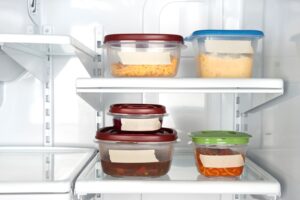Let’s get the weather moan out of the way first thing: “SHEESH, it’s hot out! No, seriously – so hot.” Well done. We have fulfilled our clichéd social obligations. Now, on to something useful and constructive.

I don’t know about you but while I love the summer sun, relentlessly high temperatures with very little breeze – which is what we’re having here in my part of the UK at the moment – wears me right out. I become lethargic, cranky and even the simplest tasks seem like major undertakings.
So what’s the solution? Well, if I was still living in Houston where heat and humidity are a daily fact of life except during a few weeks in January and February, the answer would be AC. But I am not in Houston – or even the US – so AC is not as common and the answer is circulating fans, lots of water and choosing a summer sun approach to eating.
What do I mean by that? I’m glad you asked.
The Fabulous Foodie Summer Sun Approach to Eating
Water, Water Everywhere.
The first and most basic rule of a summer sun approach to eating is hydration. I won’t bore you with lectures about the reasons for – and benefits of – drinking enough water. We’ve all heard it before and presumably we all know we should be doing it.
Oh, and by the way 6-8 glasses a day? No. There’s no actual hard basis for that oft-repeated requirement. The actual amount of water you need will vary depending on age, weight, daily activity levels, temperatures and a whole slew of other things.
The easiest and quickest way to judge is check your urine colour – clear or pale yellow? Spot on, you’re hydrated. Darker yellow means you could use a water boost. Other things to look out for – fatigue, thirst and headaches. Now these might happen for any number of reasons but if they are happening at the same time as darker urine? Definitely get some water.

But some people do find drinking lots of water a challenge so what can they do to boost their water intake. First, they can rejoice in the fact that water doesn’t mean ‘JUST WATER. AND ONLY WATER.’ Veggie and fruit juice contains water; so do tea, coffee, milk, and soda. Of course, it’s best to take a moderate approach to caffeinated drinks generally but there is no reason they can’t be part of your water calculation.
So if water doesn’t appeal at all – pour yourself a juice, pop the top on a can of sugar free fizz and get hydrating. That said, the water content of water is higher than in other drinks so to make plain water more appealing, pop a lemon or lime slice in it.
Eat Right. Eat Light.
Make sure you eat. That’s not meant to be funny. The fact is that when it is really hot out, the last thing you may feel like going is eating but instead of skipping food – which you need to replace salt losses from sweating, keep your energy levels up – try a few adjustments.
- Switch to series of smaller meals instead of larger lunches or dinners.
- Build meals around lighter options such as fish instead of meat, leafy greens instead of starches, vinaigrette instead of creamier dressings.
- Skipping breakfast when its hot out is still a no-no. Have some fruit (melons and citrus are tasty, tangy and full of water so are a great option) or make yourself a frothy, frosty smoothie. Using foods with natural cooling properties such as cucumber or mint can make these not just tasty but cool you down as well.

Cook Smarter, Not Hotter.
The last thing I want to do when the mercury rises is spend endless hours in the kitchen – a room inclined to be warmish anyway. I’m a huge fan of batch cooking as readers of this blog will know and while we tend to associate winter dishes with batch cooking (stews, casseroles, etc.) it can be an absolute life saver when you’re trying to avoid turning on the stove.
- Grab a few packs of chicken breasts or thighs (we’re thigh people in TransAtlantic Towers) and roast far more than you need for a single meal. They’ll keep several days in the fridge and are great for room temperature snacking, light lunches and shredded into salads.
- Prep some summer sauces for fast pasta dishes – pesto, as a rule, is lighter than the meat-based tomato sauces that feature in so many winter dishes. Freeze them in small amounts using ice cube trays or muffin tins and then transfer into baggies. That way you use only as much as you need and let’s face it – when the sun is scorching the last thing you want is heavily dressed pasta. A light coating is much more appealing.

- Weekends around the BBQ grill are a summer staple and a super way to keep the heat out of the house itself. You can do plenty of batch-based prep for these outdoor meals as well. Top tip for freezing hamburger patties in advance? Place wax paper between each raw burger and slide two or four (depending on what’s most useful for you) into plastic freezer bags. They’ll be ready and waiting and perfectly fine for 6-8 weeks.
Avoid cooking with heat all together.
You can – with some advanced planning and savvy shopping – avoid turning on the heat at all. I’ve touched on this before – no cook meals – when looking at leftovers. But a few quick ideas…
- Chicken salad is a breeze if you’ve got cooked chicken on hand (see, I told you that batch cooking would come in handy), some diced-up roasted red peppers, a bit of mayo and mustard, salt and pepper to taste. Then spoon the whole thing into a pita or on top of some leafy greens.
- Still have cooked chicken left? You’re half way to Asian chicken (coat the chicken in Hoisin sauce then toss with water chestnuts and chopped celery) or chicken fajitas (top tortillas with chicken, sliced green bell peppers and red onion, serve with salsa and/or sour cream).
- No-bake dessert with summer flair is easy if you have any fresh or canned tropical fruits (pineapple, mango, and papaya are good choices). Combine them with sliced almonds and a bit of coconut milk and voila! Thai fruit cup!
So don’t let the hot weather make you wilt. The summer sun approach to eating is about staying happy and hydrated, minimizing your time at the stove and eating foods that will perk you up instead of weigh you down.












